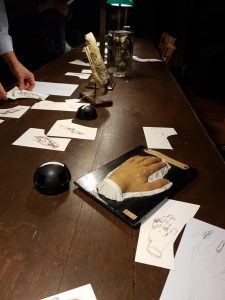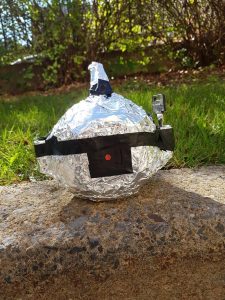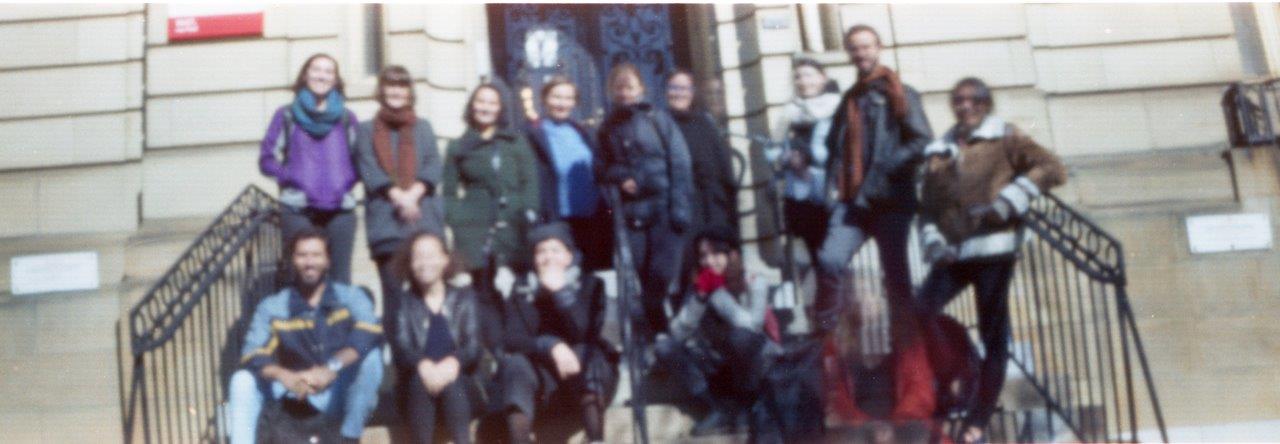By Mary Yearl, Head Librarian, Osler Library of the History of Medicine
Despite a tight schedule for the installation of her exhibit, “Impossible pathologies: re-fragmenting the archive,” Lucy Lyons carved out time to lead two workshops: an evening one for medical students and an afternoon seminar with Mary Hunter and Annmarie Adams’s ARTH 675 class. In both cases, Lyons discussed the work she did during her residency and chose specimens from the Maude Abbott Medical Museum for an observation and drawing exercise.
During her introduction to the workshop, Lyons discussed the importance of keeping an open mind, of not having preformed ideas about what one is going to see in a given space: the point is to take the time to observe, to draw (preferably with pen), and to use a focused scrutiny of one’s surroundings to open opportunities to see things hitherto unnoticed. This is a point Lyons emphasized, albeit implicitly, when advising participants to draw empty space – such as that between the fingers on a hand – for better effect.
Regarding the centrality of drawing, she made her point with a striking example: Imagine trying to describe a circle to someone who had never seen that shape. You couldn’t do it. She continued by noting that anyone can understand after seeing someone draw a circle – whether in the air with a finger, or on paper. For medical students, the message was clear: the act of drawing is critical to recall and for noticing detail. Following up on the circle example, she argued that a picture is more effective than plain text, and thus those in medicine should practice drawing as part of their process for taking patient medical histories.
*******
Loren Williams’ workshop brought us into a different area of the visual arts: photography, as explored through film and cyanotype. She opened with a description of some of the projects she has undertaken, and the link in each case between the art and the place in which it was done. Cyanotypes of birds from Redpath ultimately became an exhibition at that museum; photos from a pinhole camera made using a book and installed in the old library on Sherbrooke, were later displayed in that building. All of this provided an intriguing invitation to Williams’ upcoming exhibit at the Osler, “Materia medica.”
For the workshop, she had given every student four pieces of cyanotype paper and a map, each from a different time and place within Montreal. Students were asked to choose an area on the map to visit and to collect items from that area with which to make cyanotypes, which the students then brought to the workshop. The idea was to interact with Montreal’s medical history through maps (some of which were epidemiological) and imagery, though just how one might facilitate that interaction was left to personal interpretation.
The finale of Williams’ workshop was a seasonal delight: a group photo taken with a pumpkin camera. Yes, a pumpkin hollowed out and made into a pinhole camera.
If one can distill the emphasis of each artist to one point, Lucy Lyons’ would be that it is imperative that one take the time to stop, to reflect, to do the physical exercise of writing (drawing). For Loren Williams, an enduring point was that the beauty of a project can be as much in the process as in the final product. Both exemplified the importance to the McGill community of initiatives such as the Michele Larose – Osler Library Artist-in-Residence Programme because the unique approaches of visiting artists and scholars open up new opportunities for the interpretation of rare collections.
Une rencontre entre les arts et la médecine pour deux artistes résidentes Larose-Osler
Par Mary Yearl, Bibliothécaire en chef, Bibliothèque Osler d’histoire de la médecine
Malgré l’échéancier très serré du montage de son exposition « Impossible pathologies: re-fragmenting the archive », Lucy Lyons a réussi à se ménager du temps pour donner deux ateliers : l’un en soirée pour les étudiants en médecine et l’autre en après-midi pour les étudiants du cours ARTH 675 de Mary Hunter et Annmarie Adams. Dans les deux cas, elle a parlé des travaux effectués durant sa résidence et choisi des spécimens du musée médical Maude Abbott pour proposer un exercice d’observation et de dessin.
Dans son introduction à l’atelier, Dr Lyons a fait valoir l’importance de garder l’esprit ouvert et d’éviter les idées préconçues sur ce qu’on voit dans un espace donné : il s’agit de prendre le temps d’observer, de dessiner (de préférence au stylo) et de procéder à l’examen détaillé de ce qui nous entoure pour être en mesure de voir ce qui est jusque-là passé inaperçu. L’artiste a insisté sur ce point, quoique de manière implicite, en demandant aux participants de dessiner un espace vide – comme l’espace entre les doigts de la main – pour obtenir de meilleurs résultats.
Quant au rôle central du dessin, elle a illustré son point de vue par un exemple frappant : imaginez que vous tentez de décrire un cercle à quelqu’un qui n’a encore jamais vu cette forme. Vous ne pouvez pas le faire. Elle a ensuite fait remarquer que n’importe qui peut saisir ce qu’est un cercle – après avoir vu quelqu’un en tracer un dans les airs du bout du doigt ou sur papier. Pour les étudiants en médecine, le message était clair : le dessin joue un rôle crucial pour observer des détails et s’en souvenir. Pour mieux illustrer son exemple du cercle, elle a expliqué que l’image est plus efficace que du simple texte, et que les étudiants en médecine devraient donc se servir du dessin pour prendre note des antécédents médicaux d’un patient.
*******
L’atelier de Loren Williams présentait une facette différente des arts visuels : la photographie, explorée sous l’angle de la pellicule et de la cyanotypie. Mme Williams a commencé par décrire des projets qu’elle a entrepris et dans chaque cas, le lien entre l’art et le lieu de son exécution. Les cyanotypies d’oiseaux de Redpath ont fini par faire l’objet d’une exposition dans ce musée; des photos prises par une caméra sténopé dans un livre, installée à l’ancienne bibliothèque de la rue Sherbrooke, ont par la suite été affichées dans l’édifice. Tout cela a servi d’entrée en matière à une invitation intrigante à l’exposition « Materia medica » de l’artiste qui aura lieu prochainement à la bibliothèque Osler.
Pour l’atelier, l’artiste a remis à chaque étudiant des bouts de papier de cyanotypie et une carte, chacune représentant un moment et un lieu différents à Montréal. Les étudiants avaient comme instruction de choisir un point à visiter sur la carte et d’y recueillir des éléments pour en faire des cyanotypies, puis d’apporter celles-ci à l’atelier. L’exercice visait à interagir avec l’histoire médicale de Montréal au moyen de cartes (dont certaines étaient épidémiologiques) et de l’imagerie; toutefois, chacun était libre d’y aller de son interprétation personnelle quant au mode d’interaction.
L’atelier de Mme Williams s’est terminé par un moment agréable à saveur automnale : une photo de groupe prise par un appareil à sténopé fabriqué à partir d’une citrouille. Eh oui, dans une citrouille évidée!
Si on pouvait résumer en un seul point la démarche de chaque artiste, Lucy Lyons dirait qu’il est impératif de prendre le temps de s’arrêter, de réfléchir et de faire l’exercice physique d’écrire (de dessiner). Quant à Loren Williams, elle ferait valoir que la beauté d’un projet tient autant au processus qu’au produit final. Les deux artistes ont fait ressortir pour la communauté de McGill l’importance d’initiatives comme le programme des artistes résidents Michèle Larose – Bibliothèque Osler parce que les approches uniques adoptées par des artistes et chercheurs invités ouvrent de nouvelles perspectives à l’interprétation des collections rares.















Leave a Reply
You must be logged in to post a comment.